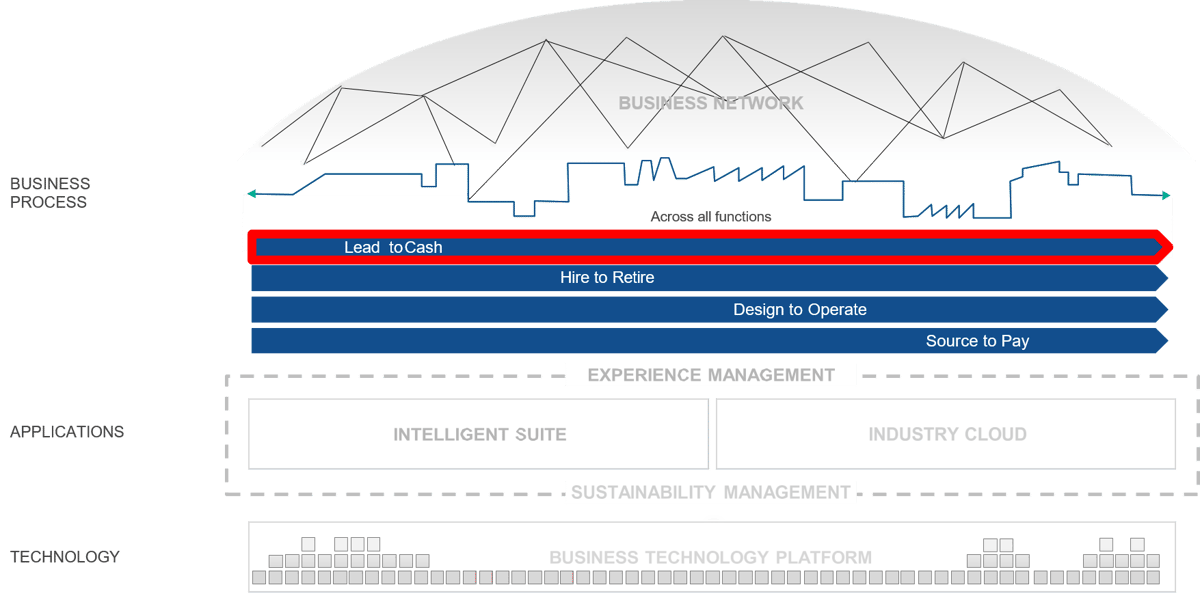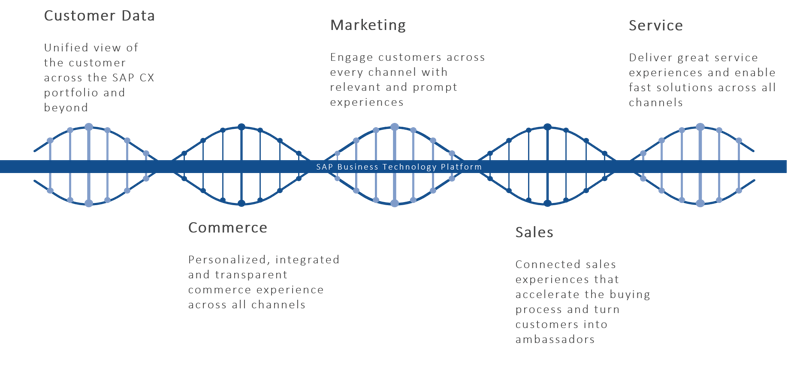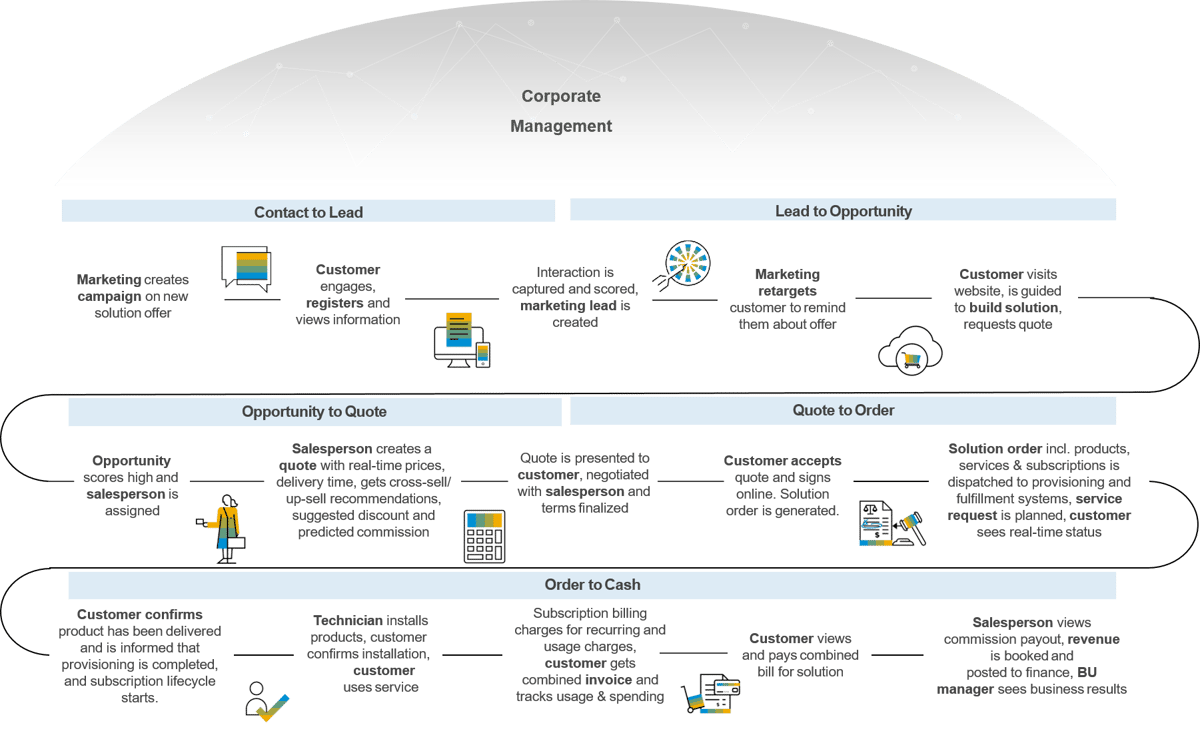The Intelligent Enterprise uses technologies for integrated and agile business processes to operate successfully and sustainably. An important building block here is the lead-to-cash process, which encompasses all points of contact between a company and its customers. The lead-to-cash process extends from initial contact and qualification through the purchasing process and order processing to the provision of services and invoicing. The customer always remains at the center. Lead-to-cash is one of four fundamental processes in Intelligent Enterprises.

We support companies in mapping their customer-related processes holistically and digitally so that companies can accompany their customers along the entire customer journey. SAP’s Customer Experience (CX) suite plays a key role in this. It comprises the areas of sales, service, marketing, commerce, and customer data. These CX solutions are supported by powerful business processes in the digital core SAP S/4HANA. The processes can be integrated and individually extended via SAP Business Technology Platform to generate maximum competitive advantages. The optional connection of further solutions such as SAP MDG, SAP Analytics Cloud and SAP Data Warehouse Cloud ensures true end-to-end processes that are secured with consistent access and authorization management.

Different tools for web shop, marketing, customer data, offers and invoices create data silos, lead to inefficiencies in the process and offer a poor customer experience. Therefore, many IT departments and business units are looking for a suitable all-in-one solution that integrates data and processes.

Source: SAP SE
Data as the basis for decisions
Daily updated, cross-departmental key figures for the visualization of the company’s performance
Incorrect decisions based on inaccurate, outdated, and non-integrated data, for example, when developing new products or entering new markets
Lost sales and low customer loyalty
The key figures in the Digital Boardroom show, for example, if the new, strategic pump has significantly lower growth rates and sales than planned. A drill-down also reveals that marketing investments in the new product are lower than planned. As a result, the pump lacks visibility in the target group. Consequently, the decision is made to invest in an additional campaign to promote the pump.
Convert unknown users into “known” leads
Segment customers based on various criteria
Execution of cross-channel campaigns with personalized content
Delivering relevant content to avoid boring customers
Ensure that product suggestions match real customer needs
Measure and track marketing activities and successes and report to management for further budgets
Poor communication with sales: too few and poorly qualified leads
Ensure future campaigns by reporting relevant metrics ROMIA, ROAS, conversion rates, etc.
Good customer experience leads to more sales and higher customer loyalty
Correct and connected 360-degree view of customers, contacts and their activities
Effective campaigns and contextualized content
Tracking of campaign results
Transformation of marketing from cost center to success factor
To be able to distribute marketing content to customers, they must be available as profiles with the appropriate consents. Interested customers can register via forms and manage their data, preferences and data protection settings via self-service.
In order to access uniform customer data in all systems, integrations between the individual SAP products are required. For example, they make it possible to keep SAP Business Partner in SAP S/4HANA, in SAP Commerce Cloud, SAP Marketing Cloud, SAP Customer Data Cloud and in other systems at the same level and synchronized. With the help of “SAP Commerce Cloud Integration with SAP S/4HANA Cloud” it is possible to replicate the SAP Business Partner between the systems.
Following instructions from the management board, a campaign is created for the new pump and rolled out to existing customers. A wide range of segmentation options and channels are available for this purpose. Regulatory framework parameters such as the GDPR are taken into account in the campaign.
Creating quotes with the right prices, discounts, and combinations of products and services
Compliance with margins
Cross-selling and up-selling
Communicating with customers on different channels
Working in the CRM system on the go with mobile devices
Complete information and item numbers, as missing data leads to poor customer experience and missing quota targets
Accurate and networked information to operate the system “on the side”
Investing precious time in the right deals
Increase in the volume of offers
Increased efficiency through reduced dependencies on other departments
Intelligent support and suggestions based on historical data
Accurate quotes and forecast values
Continuous improvements through targeted customer feedback
Transparency for the customer thanks to commerce integration, resulting in fewer customer calls or emails for status updates
SAP CPQ integration with SAP Commerce Cloud helps companies get the right quote with the right product and the right price as quickly and flexibly and without errors. The integration supports both standard products and configurable products.
When converting the opportunity into a quote, the processor has access to all relevant information: pricing, margins, product availability. This minimizes dependencies on other departments, which increases efficiency. Planning and documenting activities enables perfect preparation and presentation of the offer.
As of SAP S/4HANA Release 2021, a native Fiori app is available for creating and editing sales orders. It provides an intuitive user experience and simplifies the daily work of sales employees by clearly displaying all important information on a single screen – including easy navigation.
Based on the products in the offer, additional articles and services are suggested. The pricing of these products is done automatically from the SAP S/4HANA system. The automatic proposal of a discount based on historical data increases the probability of winning the deal.
Missing information on technicians, qualifications, availabilities and times
High potential for errors due to incomplete information and media disruptions
First point of contact for customer anger
Overbooking of technicians, wrong priorities and incorrectly planned assignments due to faulty information
Sandwich position between customer and technician
Contract cancellations, lack of repurchases and poor reputation due to bad service
Fast, accurate and efficient assignment of technicians by bundling integrated information.
Fast fulfillment of customer requests, resulting in high satisfaction levels
Reduction in the number of technician assignments through predictive scheduling
Proactive scheduling suggestions based on historical data, skills, availability, and geography
Avoidance of implicit knowledge for scheduling technicians
Targeted communication between back office, technicians and customer
The integration of SAP Commerce Cloud with SAP Subscription Billing enables subscription and usage-based services to be monetized, sold across multiple channels and touchpoints, billed, and revenue recognized. The integration has several replication processes that conveniently keep data up to date on both systems asynchronously. This allows simple cron jobs to be scheduled to replicate store configurations, customer data, product information, pricing, etc.
Based on the feedback, proactive measures are started in the back office. Was the customer dissatisfied with the technician’s qualifications? Were the service levels even exceeded? Would the customer like to buy additional products? Integrating the feedback data into the operational process ensures that the customer’s voice is also heard.
Rapid completion and speedy dispatch of invoices for quick receipt of money
Lack of knowledge if products are at the customer and services have been provided
No tracking of open items or their follow-ups
Poor liquidity, incorrect quarterly figures and angry customers due to inefficiencies in the process
Fast and accurate order processing and invoicing
Understanding of orders and invoices by customers through integration of actual content and feedback
Central system where all data converge without media disruptions
Fewer internal queries thanks to transparent data and statuses
The integration of the sales and service systems with SAP S/4HANA leads to immediate invoicing of services with seamless tracking from the quotation to the order and the service log to the invoice.
Simply complete the form and submit it. We will get back to you as soon as possible.

SAP S/4HANA is the key to new business models and greater efficiency in processes. SAP’s next-generation ERP system forms the digital core of the intelligent enterprise.

High-quality master data is an indispensable success factor for companies. It offers valuable insights and provides the basis for efficient business processes. To meet these requirements, the data must be up-to-date, consistent and available to all departments.

Authorizations in SAP systems form the basis for Identity & Access Management. They enable users to access the applications they need to perform their activities.

Intelligent controlling based on defined KPIs is essential for successful corporate management. Thanks to real-time reporting, you are always in a position to take the right measures. With predictive analytics, you create forecasts for the future and can initiate strategic decisions at an early stage.

Simplify and optimize your sales planning. Our Sales Planning Dashboard gives you the overview you need to define a targeted, structured approach and derive recommendations for action.

In view of the increasing complexity of IT architectures in companies, the importance of integration is constantly growing. The aim is to integrate software solutions quickly and flexibly – regardless of whether they are deployed on-premise or from the cloud.